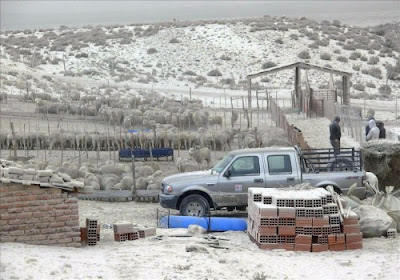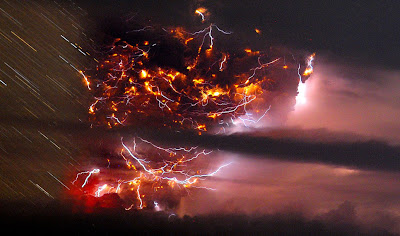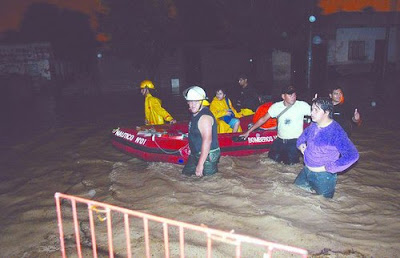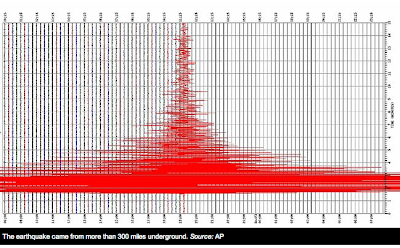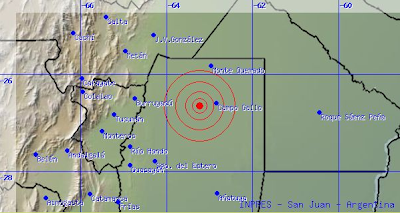[from Antonio Gaspar @
El Tribuno, 17 April 2011]
PRONOSTICAN QUE EN LOS PRÓXIMOS 20 A 50 AÑOS, DURANTE EL VERANO AUMENTARÁ EL NIVEL DE PRECIPITACIONESCambio climático: El Valle de Lerma tiende a convertirse en una región tropical (will likely change into a tropical region>El calentamiento global sumado a la acción del hombre hará que la zona se vuelva más húmeda y sin tanta amplitud térmica (
the zone will turn wetter with a narrower thermal range). En un sentido inverso, los inviernos se volverán más secos y benignos (
winters will turn drier & milder). Un llamado de atención para la planificación urbana.
El término antropogénico se refiere a los efectos, procesos o materiales que son el resultado de actividades humanas.
La isla de calor es acumulación de calor por la inmensa mole de hormigón, y demás materiales absorbentes de calor. (
The island of heat is heat concentration due to the immense quantity of concrete, & other heat-absorbing materials.)
Explicar cómo el Valle de Lerma tiende a convertirse en una zona tropical no es tarea sencilla.
Desde una aproximación teórica y con mucha precaución el meteorólogo del
INTA, Ignacio Nieva, dialogó extensamente con El Tribuno sobre cómo incidirán en el futuro el calentamiento global y los cambios climáticos, que son reales, y que se pronostican para el valle donde se recuesta la ciudad capital.
Asegura que si bien no cuenta con la cantidad necesaria de datos e información para hacer más rigurosos sus planteos, el especialista parte de hipótesis con grandes posibilidades de que se confirmen.
Primero toma en cuenta el calentamiento que se produce a una escala global con el aumento incesante de dióxido de carbono.
Este paulatino aumento de la temperatura afectará de manera diferenciada en cada región en el mundo; pero modificará gran parte del sistema de vientos que son, al fin y al cabo, los que inciden de manera directa en las condiciones climáticas de cada zona en particular.
En ese sentido afirma que los trópicos meteorológicos no coinciden con los geográficos. Los primeros son más dinámicos y fluctúan en su posición por lo que se espera que en los próximos 50 años tiendan a ensancharse aún más.
Para nuestra región debe decirse que el “trópico de Capricornio meteorológico” tenderá a moverse hacia el sur, con grandes posibilidades de que llegue en su extremo hasta el Valle de Lerma.
AntropogénicoA todos los condicionantes antes mencionados, y que de alguna manera resulta imposible modificar, hay que sumarle la acción del hombre que específicamente realiza en el Valle de Lerma.
En primer lugar destaca el enorme crecimiento de la ciudad de Salta en tan pocos años.
La superficie urbana de la capital provincial tuvo un desarrollo exponencial en los últimos 30 años. Esto derivó en que crezca de manera proporcional la cantidad de vehículos que funcionan con combustibles fósiles y que emiten una gran cantidad de dióxido de carbono.
Al aumentar el territorio de la ciudad también creció la cantidad de zona asfaltada y de construcciones con hormigón creando una gran isla de calor. Estos materiales atrapan el calor y no dejan que las altas temperaturas se disipen por las noches, contrariamente a lo que sucede en las zonas rurales.
Además, debemos tener en cuenta que Cerrillos, Vaqueros y San Lorenzo ya forman parte de un gran conglomerado urbano que no se detiene. A la proyección de cómo y cuánto crecerá la ciudad en un plazo de entre 20 a 50 años aún nadie la planteó.
Hipótesis y presuncionesEn conclusiones climáticas de Nieva, si bien no aumentarán las temperaturas promedio lo que sí se elevarán serán las mínimas, por lo que la amplitud térmica será menor.
Esto, en el verano, podrá ocasionar un aumento en las precipitaciones; y volverá al invierno más seco de lo que es ahora.
En consecuencia, el meteorólogo del INTA considera que lo que se tendría que tomar en cuenta para su estudio es el comportamiento del agua en este nuevo panorama climático.
En este sentido, se tiene que tener en cuenta que los inviernos serán más secos por lo que previsión y la provisión de agua se volverá (hoy ya lo es) un tema central para la construcción de nuevas urbanizaciones.
Por lo tanto, se deberá pensar en el futuro (porque aún no está ni soñado por nuestra clase política), en controlar y estudiar las crecidas de los ríos, volver a buscar las cuencas hídricas, pensar en una mejor distribución de la urbanización y en realizar estudios serios y a largo plazo articulando la información oficial con la obtenida por los científicos de las universidades.
Por último, Nieva rescata las acciones de los estadounidenses respecto del estudio de los huracanes y afirma que si bien no los pueden detener lo estudian para que tengan el menor impacto en la población. Y dice que eso es lo que deberíamos hacer en Salta a nivel gubernamental y científico. Aunque por lo pronto, y como primer paso, es necesario establecer la tema como una problemática concreta, que es real y que ya está comenzando a suceder.





